Acwa power
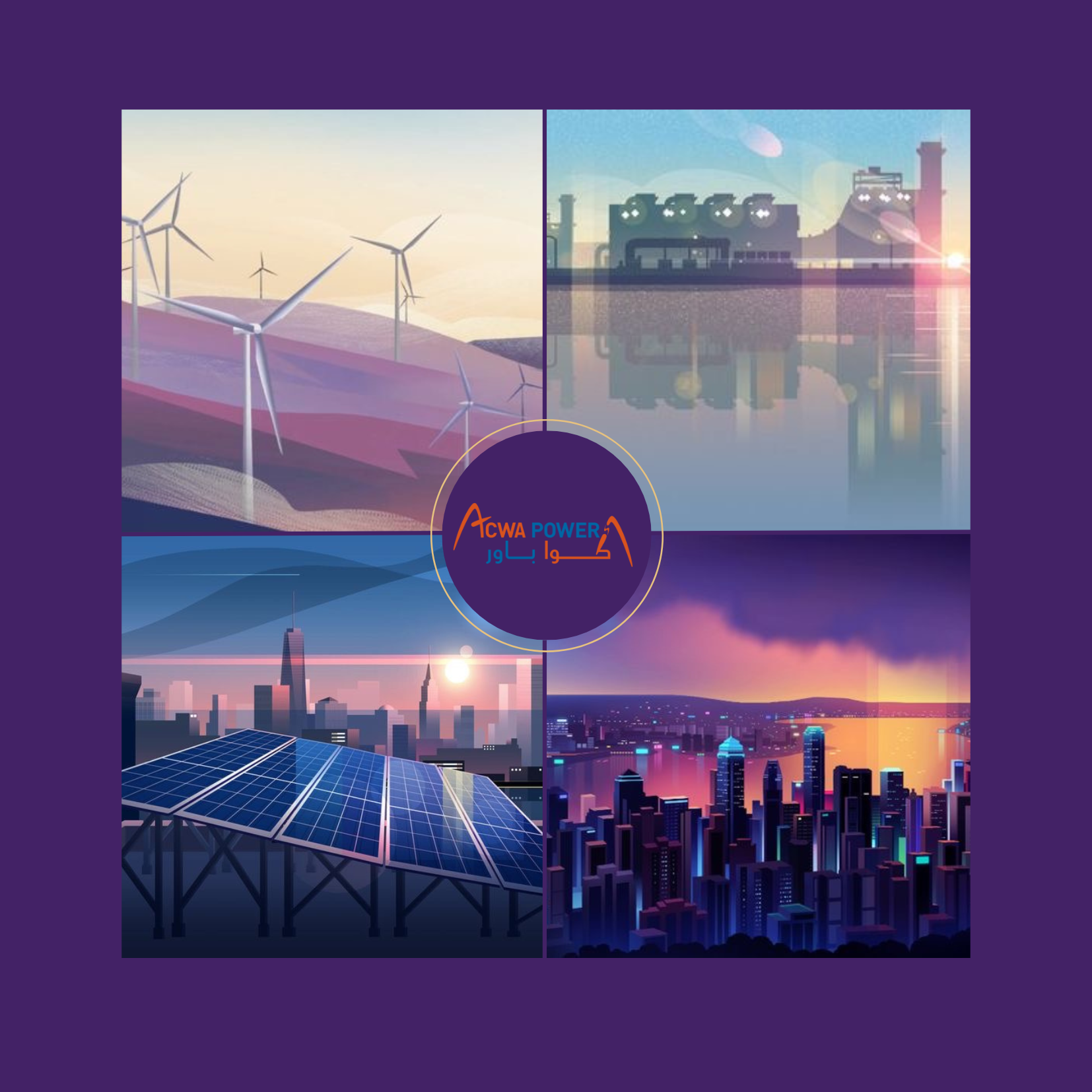
The public utilities sector is a sector that includes companies that provide basic services, such as electricity, utility water, natural gas, and others.
It is possible that there are many people who find it difficult to differentiate between the utility sector and the energy sector, the main difference between them is that the energy sector provides energy resources to the utility sector while the utility sector provides utility services to customers.
The utilities sector is considered one of the best sectors at the time of an economic downturn and may not be affected by this downturn due to the constant and recurring importance of its presence in people's lives.
The utilities sector has grown globally from $ 6000.19 billion in 2022 to $ 6416.54 billion for 2023 with an accumulated annual growth rate of 6.9%, and the sector is expected to grow to $ 8314.78 billion in 2027 with an accumulated annual growth rate of 6.8%.
The rapid growth in renewable energy investments is expected to drive the utilities sector in the future. In addition, governments support renewable energy sources by offering incentives to solar power generation companies.
Like many sectors, COVID-19 impacted the utilities sector as it represented a significant constraint on the sector for 2020, as demand for utility services by industrial and commercial establishments decreased due to trade restrictions and lockdowns imposed by governments globally. Many manufacturing facilities globally have halted operations to contain the spread of the virus among their workforce, reducing the need for utility services such as electricity and wastewater treatment.
The public utilities sector in Saudi Arabia is one of the largest sectors and includes the largest companies providing basic utilities such as electricity through renewable energy, water, and natural gas, and Vision 2030 for the Kingdom of Saudi Arabia aims to diversify, expand, and grow the sources of this sector as it is essential and important for society.
Due to the importance of this sector and the lack of companies listed in it, we find that the demand for investment in it is continuous and high, and as a result, the sector's shares are relatively stable.
The following figure shows the performance of the sector in the Kingdom during the past five years:
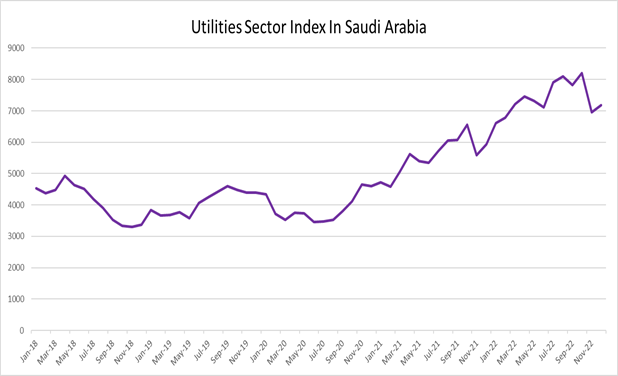
Globally, the production of energy during the past ten years has grown by 2.2%, from 21,570 terawatt/hour to 26,823 terawatt/hour. In addition, the production of electricity from renewable sources has increased by 15.25%. The legal assistance provided by different governments has been vital to progress.
Where in Saudi, Solar photovoltaic electricity costs have decreased by 85% since 2010, and the costs of both onshore and offshore wind generation have decreased by about 50%.
In reality, demand for renewable energy sources rose in 2020 despite the epidemic, while usage of all other fuels decreased.
The share of renewables in the total energy mix grew from 3.53% in 2010 to 11.73% in 2020 and is expected to jump to 30% by 2030.
The Kingdom's Vision 2030 stipulated a plan to diversify investments away from oil. Moreover, the General Environment was introduced to achieve observable results in 2023 as a first stage. Localizing a large percentage of the renewable energy value chains in the national economy, including research and development, manufacturing, and other activities. In order to achieve this, the National Renewable Energy Program has established a strategic plan in light of the Kingdom's Vision 2030 and the King Salman Renewable Energy Initiative. Both programs aim to maximize Saudi Arabia's share of renewable energy production.
ACWA Power intends to establish the first voluntary market for carbon bio-trading, allowing the company's products to be traded locally and accelerating renewable energy projects in Saudi.
After getting to know ACWA Power's sector, we will take a closer look at the company and its services.
Acwa Power is a leading energy supply and water desalination company that thrives on a proven track record in the energy field, starting from solar energy, concentrated solar energy, geothermal energy, wind energy, waste-to-energy, and clean coal.
Company’s achievements:
- In 2016, the company-led consortium won the construction deal for the Noor 4 project in the Kingdom of Morocco.
- On June 4, 2018, the Saudi Public Investment Fund and the international water and energy business company ACWA Power announced that the fund had acquired an important stake in ACWA Power, becoming a direct shareholder in ACWA Power with a 15.2% stake.
- On November 19, 2020, the Public Investment Fund announced an increase in its stake in AquaPower from 33.36% to 50%.
The company represents 6.95% of the utilities sector market in Saudi Arabia.
Chronology of Acwa Power's most important events:

After getting to know the company, its activities, and its most important events, we will take a quick look at its three biggest competitors.
1- Saudi Electricity Company
The Saudi Electricity Company's primary functions include the production, transmission, and distribution of electricity inside the Kingdom of Saudi Arabia, which has the largest economy in the GCC and is one of the top 20 economies in the world. The business supplies all types of consumers with energy and is the exclusive owner of the transmission and distribution system throughout the Kingdom.
It holds an 89.8% market share.
2-Al-Khorayef Company for Water Purification and Energy
One of the top businesses in the Kingdom of Saudi Arabia market is Al-Khorayef Company for Water and Energy Technology. It also holds a leading position in the fields of construction, operation, and maintenance as well as water and wastewater services. With a market share of 0.73%. Al-Khorayef Water and Energy Technology develops, builds, operates, maintains, and oversees all types of water and sanitation projects, including industrial sewage plants, water treatment and desalination plants, as well as water and sewage networks, lines, and connections for residential buildings, pumping and lifting stations, electromechanical works, rainwater projects, and water wells.
3- National Gas and Manufacturing Company
Through a network of fueling stations spread out over the Kingdom of Saudi Arabia, it engages in the business of delivering liquefied petroleum gas. Liquefied petroleum gas is transported, packaged, and sold by the company. It also sells empty cylinders and tanks that are ready to transport gases to customer locations. The business may engage in operations involving the production, distribution, and marketing of commodities derived from petroleum and chemicals, glass, equipment and spare parts for automobiles, the creation of petroleum service centers, and the upkeep of machinery and vehicles. The company has a market share of 2.5%.
For a detailed analysis of the company's profitability, the management at DuPont Corporation created a model known as DuPont Analysis in the 1920s. A DuPont Analysis method could help us avoid drawing incorrect inferences about a company's profitability. Using the basic DuPont Analysis model, operating efficiency, asset efficiency, and leverage factors can be separated from the original ROE equation.
Using this type of analysis, ACWA Power compared to the three competitors.
Interest Burden
Interest burden simply is the ratio of pre-tax profit to earnings before interest and taxes (EBIT). It shows the percentage of EBIT left over after the deduction of interest expense.
In order for a company to achieve a high return on equity, it must reduce interest expenses.
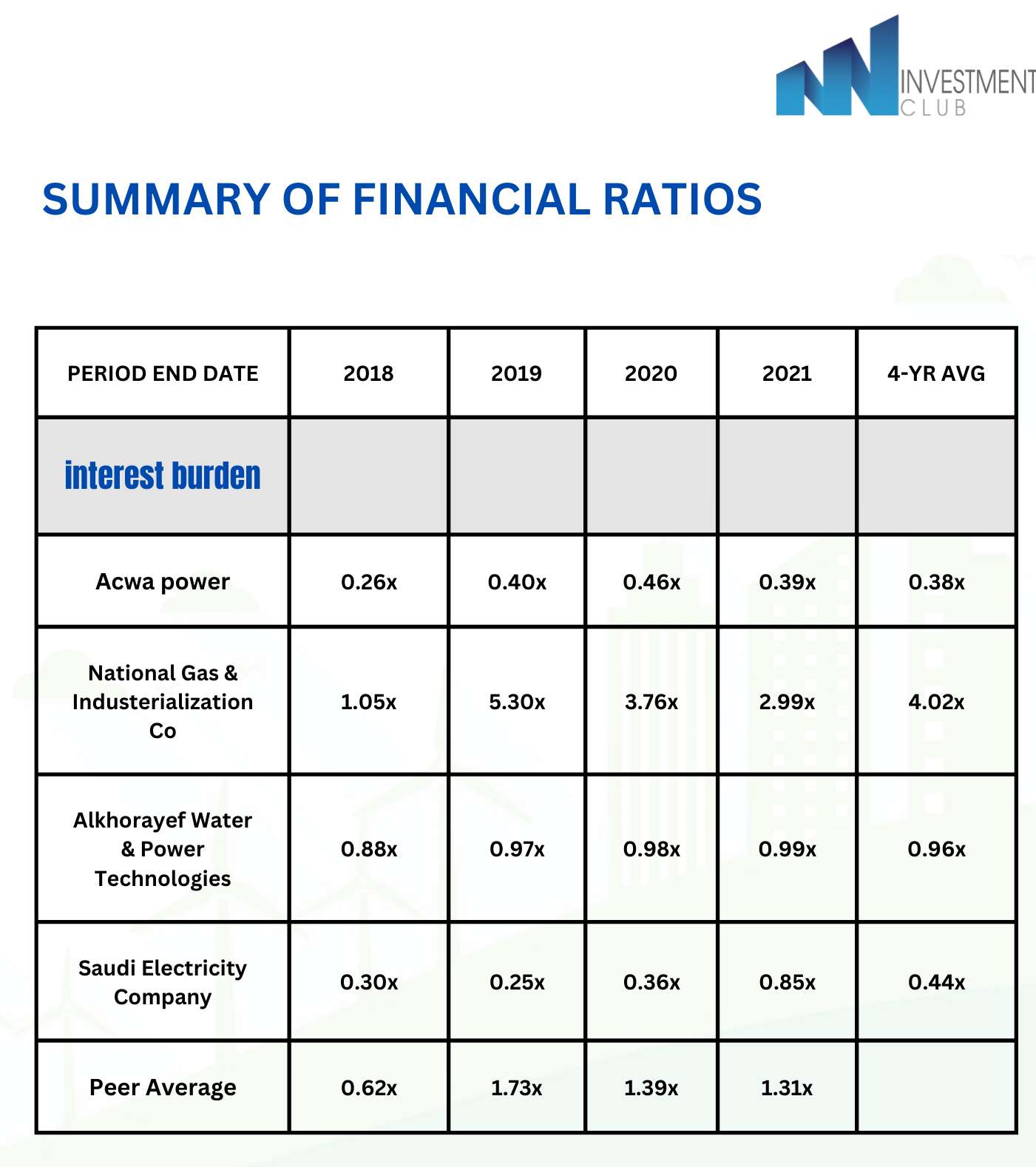
AcwaPower's interest burden decreased in 2021 by 15.56% compared to 2020 due to an increase in interest expense from 1,030,840,000 in 2020 to 01,080,690,00 in 2021.
As for the interest burden of ACWA Power's competitors, the National Gas and Industrialization Company achieved the highest average interest burden in the period from 2018 to 2021 with an average of 4.02x, followed by the Saudi Electricity Company with an average of 0.44x, Alkhorayef got 0.96x, and the last Aqua Power came representing the lowest average among competitors and equivalent to 0.38x. This shows that ACWA Power's interest expense affects its profits more than its competitors.
Tax burden
It is the ratio of net income to income before tax, that is, it shows the extent to which tax affects the company's profits.
The tax burden is less for companies that make less net profit.
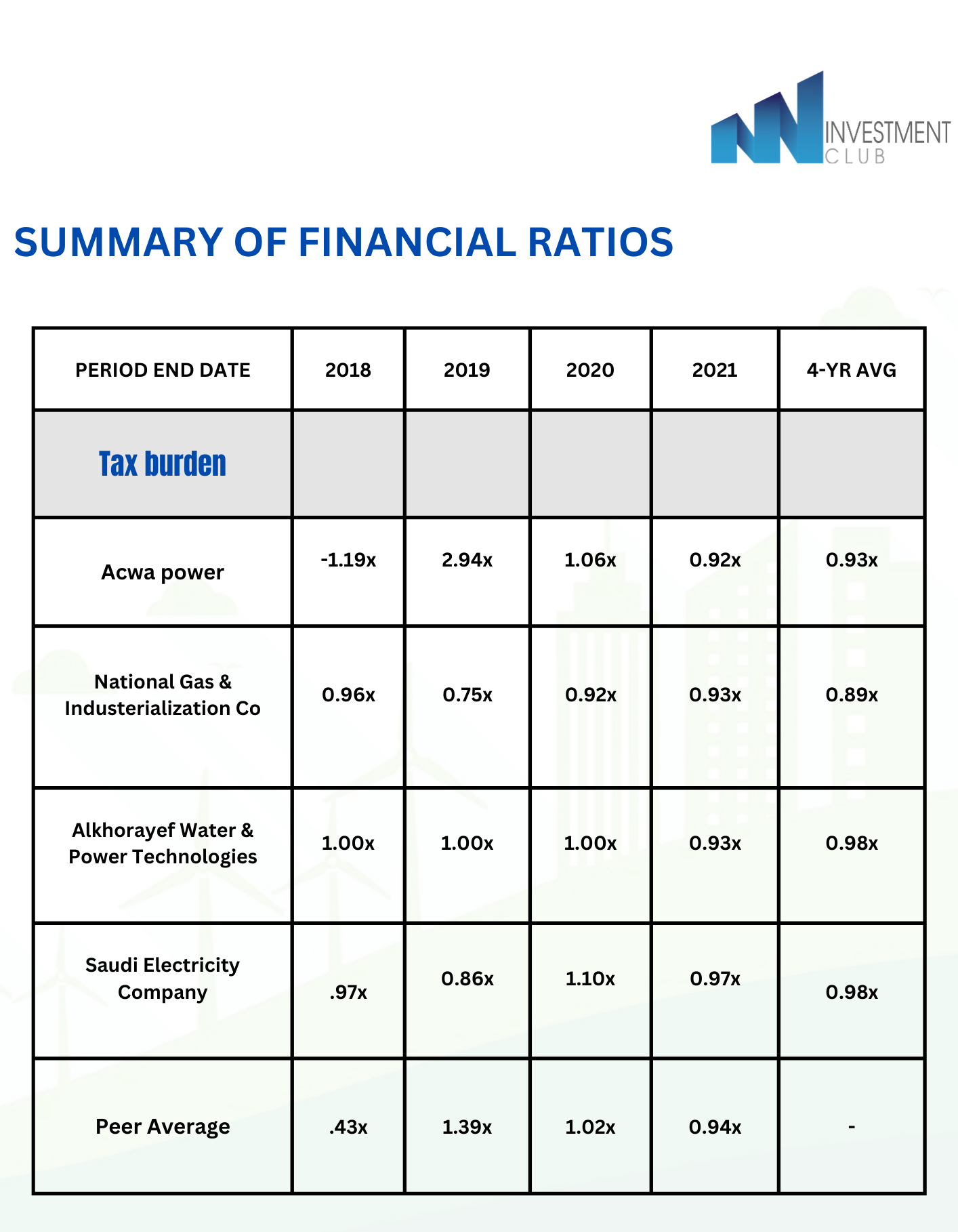
We note that the 2021 tax burden of Acwa Power decreased by 13.54% compared to 2020 due to the increased impact of tax on the company's profits.
As for the tax burden of competitors, Alkhorayef Water & Power Technologies Company and Saudi Electricity Company achieved the highest average, which is equivalent to .98x, which means that the impact of the tax on the profits of the two companies is lower than their peers.
Asset turnover
It refers to the efficiency of the company's assets in generating revenue or sales, meaning that each riyal of assets can generate how many riyals of sales?
The higher the ratio, the greater the efficiency of the company in using its assets to generate profits.
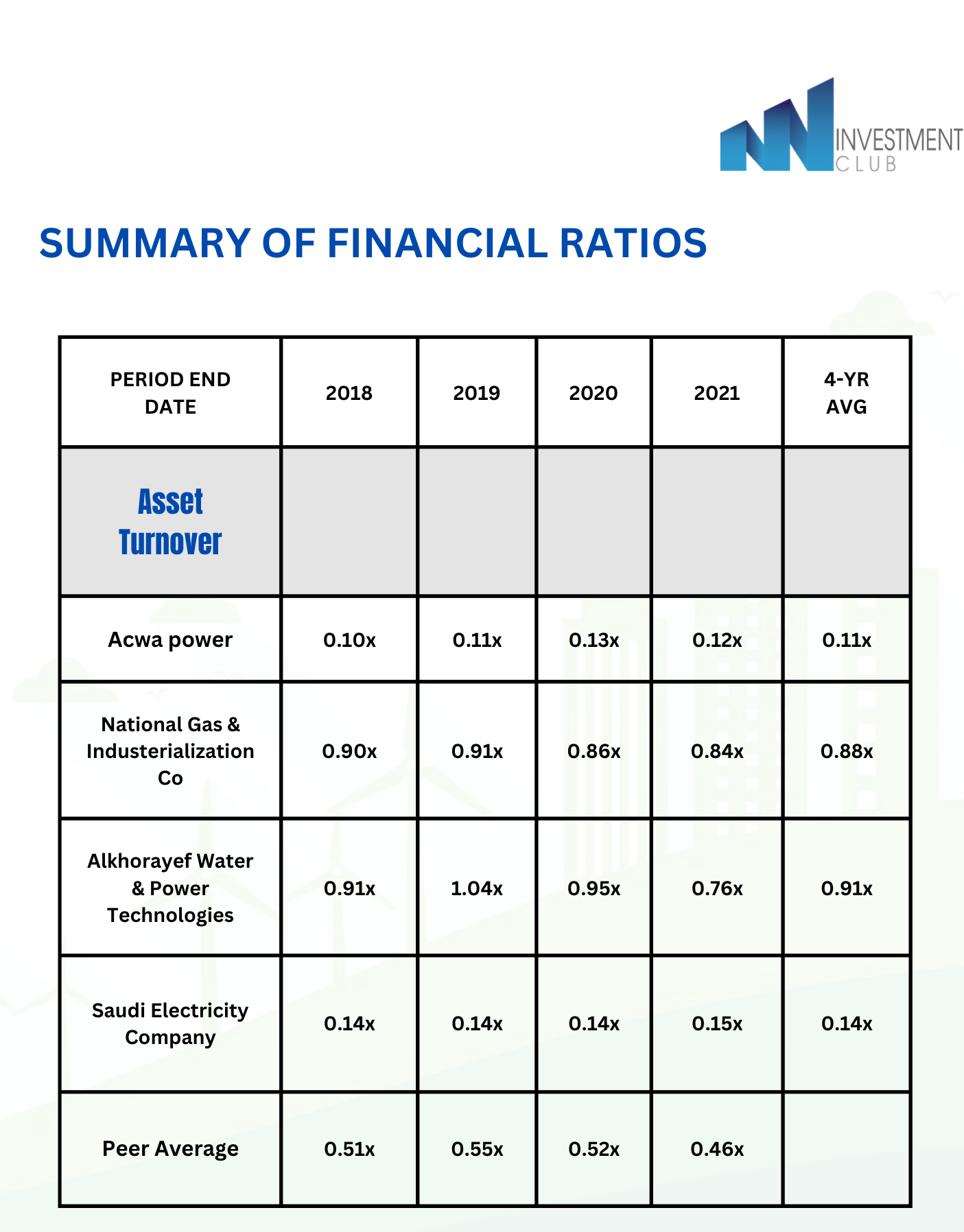
For ACWA Power's competitors due to the average four-year asset turnover per company, ACWA Power achieved the lowest ratio of 0.11x, while for its competitors, Alkhorayef Water and Power Technology achieved the highest asset turnover ratio of 0.91x, which may indicate higher efficiency of using assets to generate revenues for the company.
Leverage
It is the ratio of assets to equity, which shows how much of the assets were funded from equity.
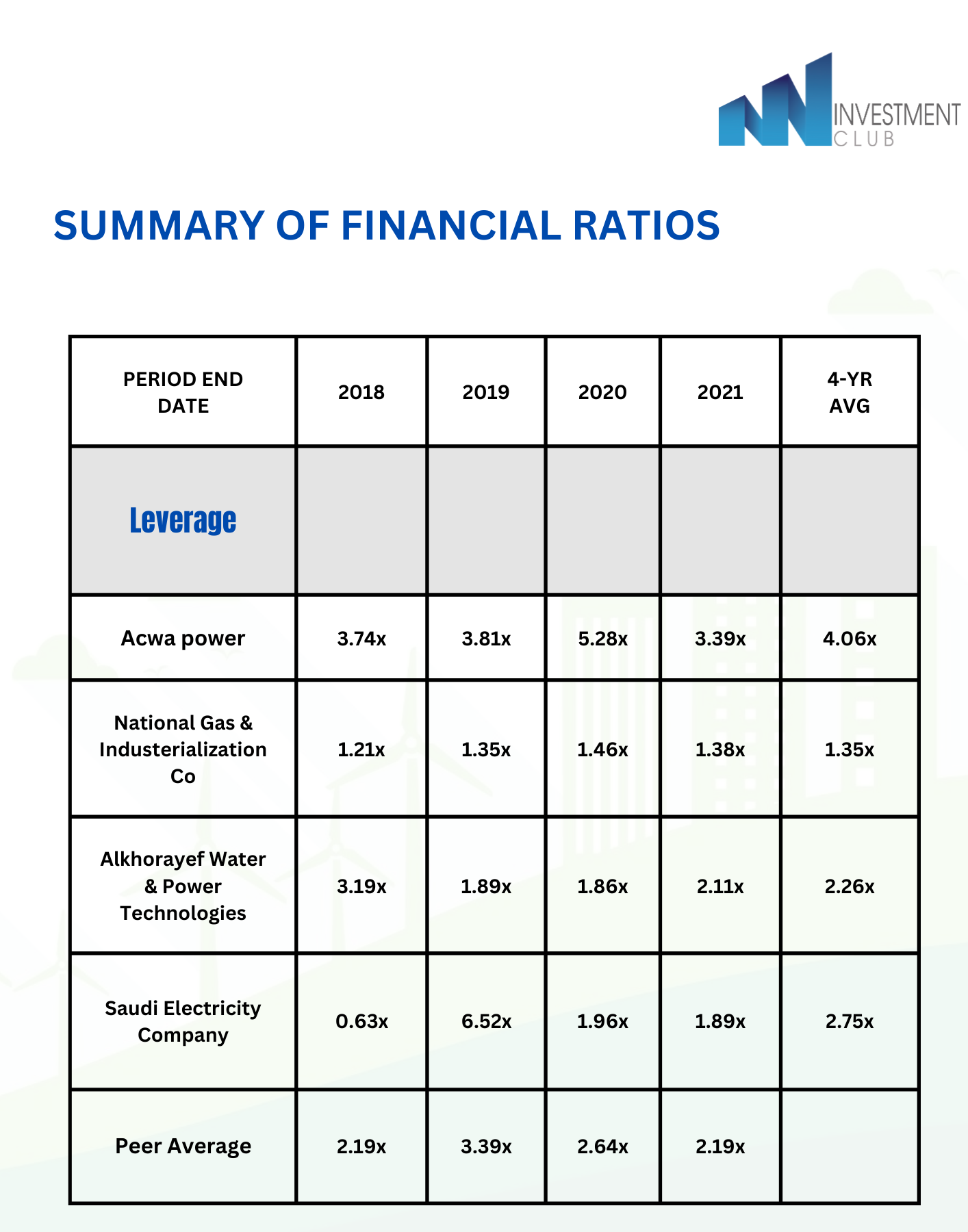
Due to ACWA Power's four-year debt ratio, we note that the ratio has stabilized to some extent, with an increase in 2020, which shows that the company's reliance on financing its equity assets increased during that year.
Compared to its competitors, they have the highest average, which indicates that the company relies less on debt to finance its assets than its peers.
Profit margin
A measure of a company’s profitability is expressed as the percentage of revenue the company keeps as profit. A high-profit margin indicates that a company is successfully producing profit over and above its costs. Also, the Profit margin is an indicator of a company's how well it controls its cost.
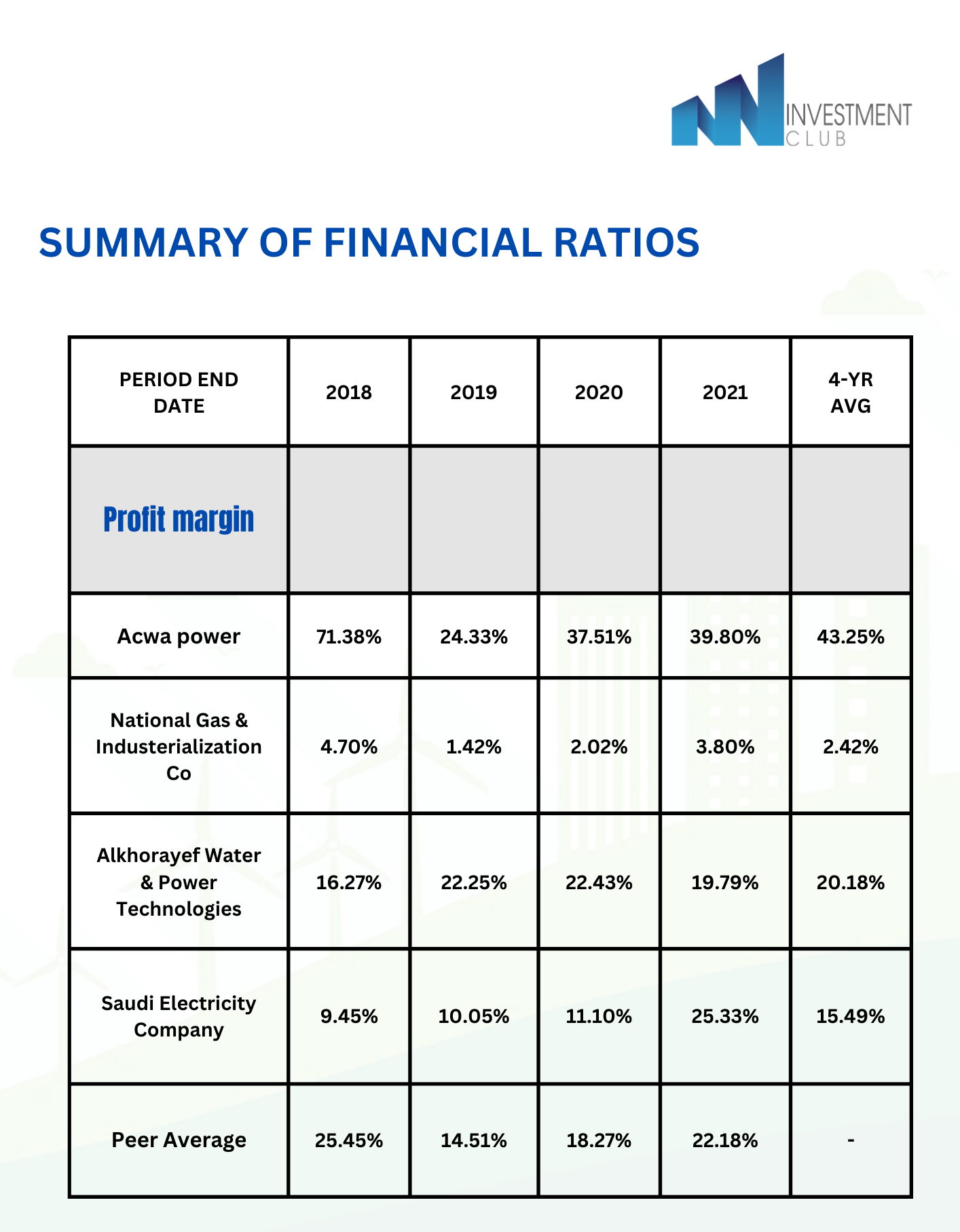
In 2018 the profit margin of Acwa power was 71.38%, which was higher than the industry average, indicating the efficiency of the company's control of its cost.
In 2019 the profit margin declined by 65.9% due to an increase in cost but still, Acwa power has a profit margin more than its competitors which were Alkhorayef at 22.25%, Saudi Electricity Company at 10.05%, National Gas at 1.42% and higher than the industry average 14.51%.
In 2020 and 2021 the profit margin improved respectively by 37.51% and 38.80% and the reason for that was an increase in its sales higher than its competitors, also higher than the industry which was 18.27% and 22.18%.
For the past four years, Acwa power had a profit margin of more than its competitors also higher than the industry.
Return on Equity
It measures how efficiently a company generates profits from equity.
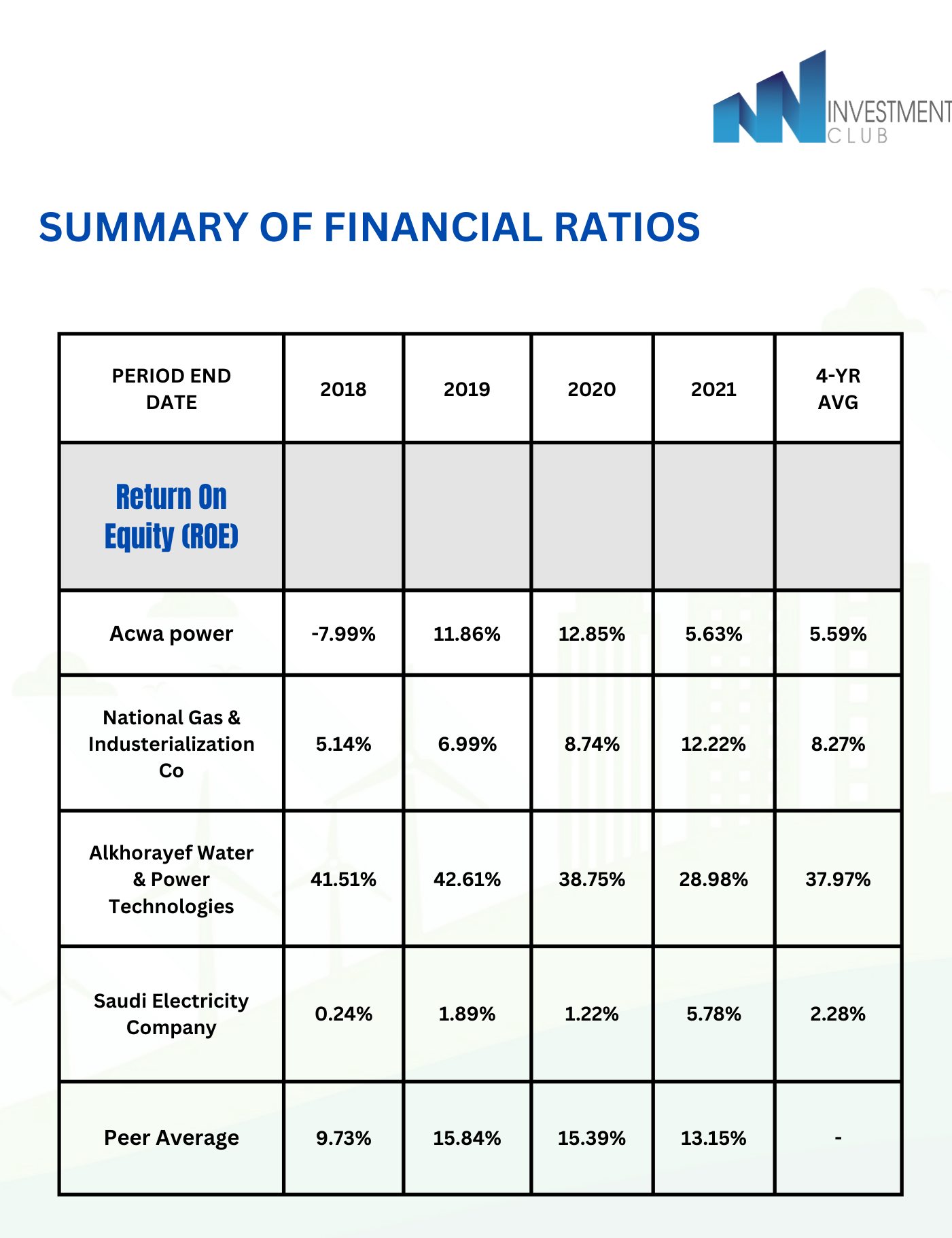
We note that Acua Power's efficiency in generating profits from equity has been low over the four years, and we note the same with its competitors, but we exclude Alkhorayef Company, as it represents the highest return on equity, which means that it is more efficient in generating profits from equity.
Here is a summary of the charts:
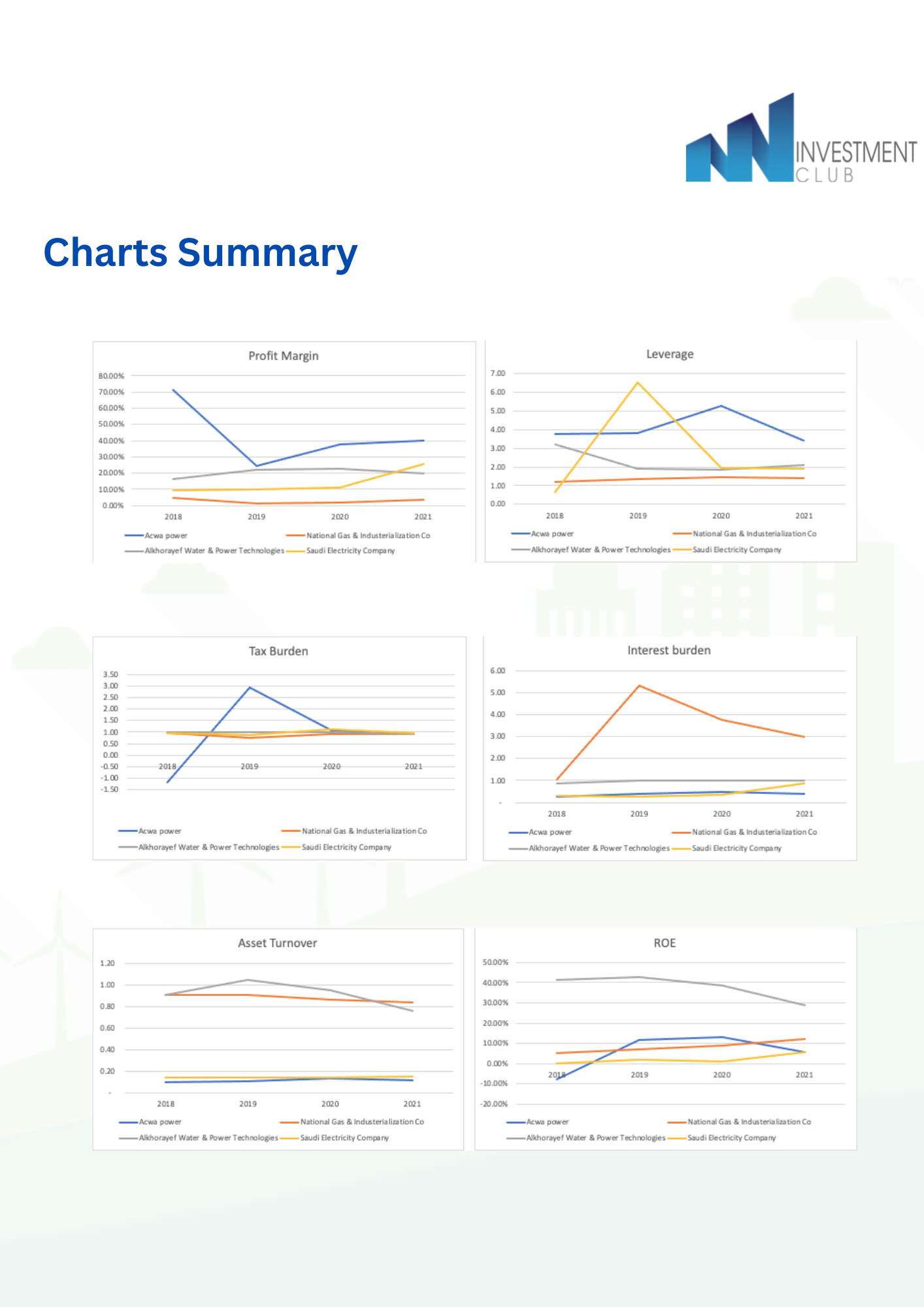
To see the full analysis:
Resources:
https://www.blackridgeresearch.com/reports/saudi-arabia-renewable-energy-market https://acwapower.com/ar/projects/assets/ https://acwapower.com/ar/about-us/company-history/ مؤشر قطاع المرافق العامة - السعودية - SASETUTI:IND - اقتصاد الشرق مع بلومبرغ (asharqbusiness.com) ما هو قطاع المرافق؟ (portalfamososbr.com)
Prepared By:
Sarah Alotaibi
Noura alfulij
Razan Alghamdi
Hessah Alzamil
Munira Alqaoud